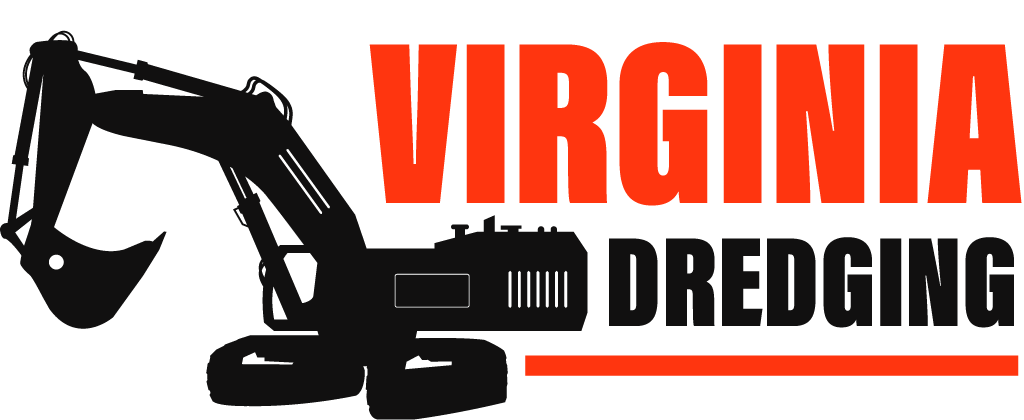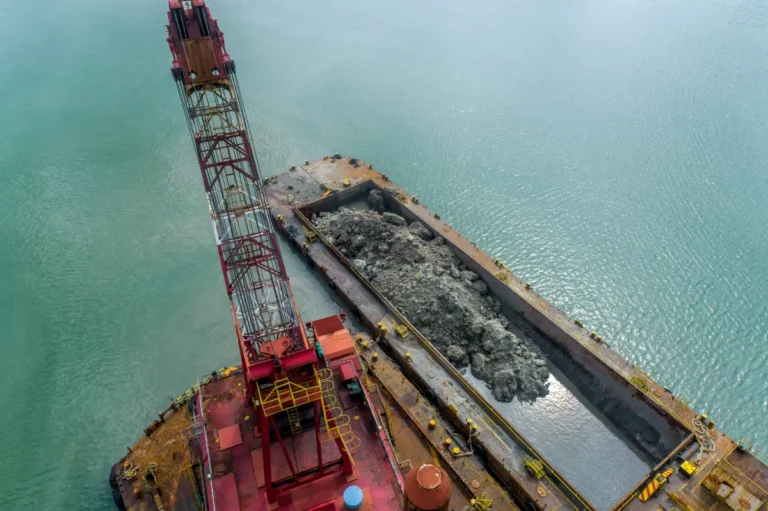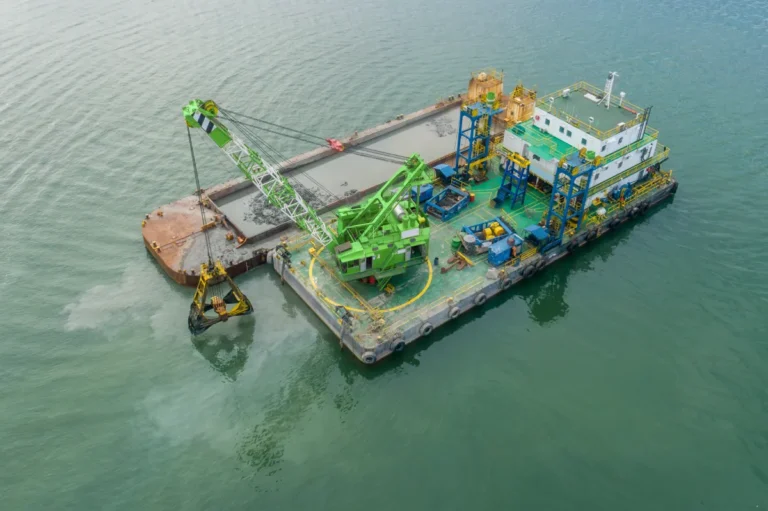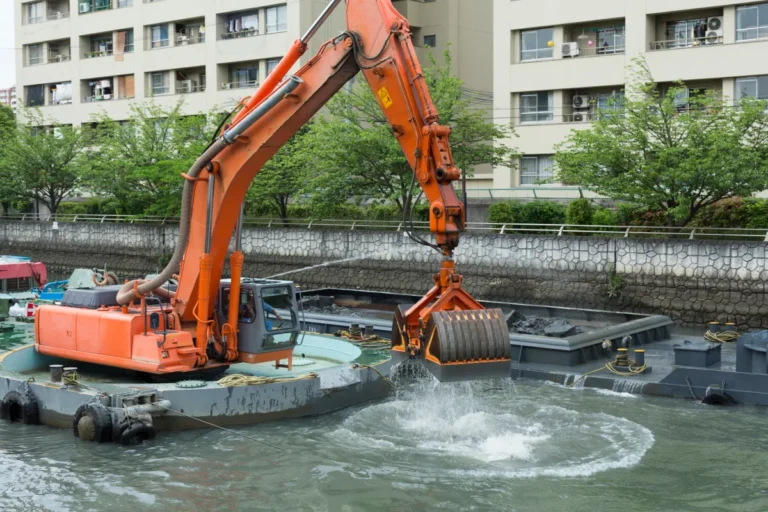Overview of Harbor Dredging
Harbor dredging is the process of removing sediment, debris, and other materials from the bottom of harbors and shipping channels to maintain or increase water depth. This essential practice ensures that ports remain navigable for vessels, allowing for the smooth flow of trade and transportation. Over time, natural sedimentation, erosion, and human activities can reduce harbor depth, creating challenges for shipping operations.
Using specialized harbor dredgers, the dredging process restores the necessary depth, enabling safe and efficient vessel passage. This process is critical not only for large commercial shipping ports but also for smaller harbors that support local industries and recreational activities. By addressing sediment buildup, dredging for harbors ensures that ports remain functional and capable of accommodating modern, larger ships with deeper drafts.
Connection Between Harbor Dredging and Economic Growth

Efficient harbors are the backbone of global trade and local economies. With over 80% of international trade carried by sea, maintaining operational ports is crucial for facilitating imports, exports, and economic expansion. Harbor dredging directly contributes to economic growth by enabling ports to handle larger vessels, which increases cargo capacity and reduces shipping costs.
For local economies, functional harbors drive job creation in industries such as shipping, logistics, and tourism. Additionally, dredging for harbors allows ports to remain competitive in attracting international trade routes, boosting investment and infrastructure development in surrounding areas. In essence, the effectiveness of a harbor is a key factor in determining its contribution to regional and global economic stability.
Harbor dredging ensures adequate depth and navigability, supporting the seamless flow of goods and enhancing a port’s capacity to foster economic growth and development.
What Is Harbor Dredging?
Definition and Process of Harbor Dredging
Harbor dredging is the systematic removal of sediment, debris, and other obstructions from the bottom of harbors, shipping channels, and docking areas to maintain or increase their water depth. This process is essential for ensuring the safe and efficient navigation of vessels, particularly as natural sedimentation and human activities can gradually reduce the depth of these waterways.
The process of dredging for harbors typically begins with a survey to assess sediment accumulation and identify areas requiring attention. Once a plan is developed, specialized equipment is deployed to remove the sediment. The dredged materials are then transported to designated disposal or reuse sites, such as land reclamation projects or habitat restoration efforts. This ensures the cleared waterways are both functional and environmentally managed.
Key Equipment Used in Dredging for Harbors
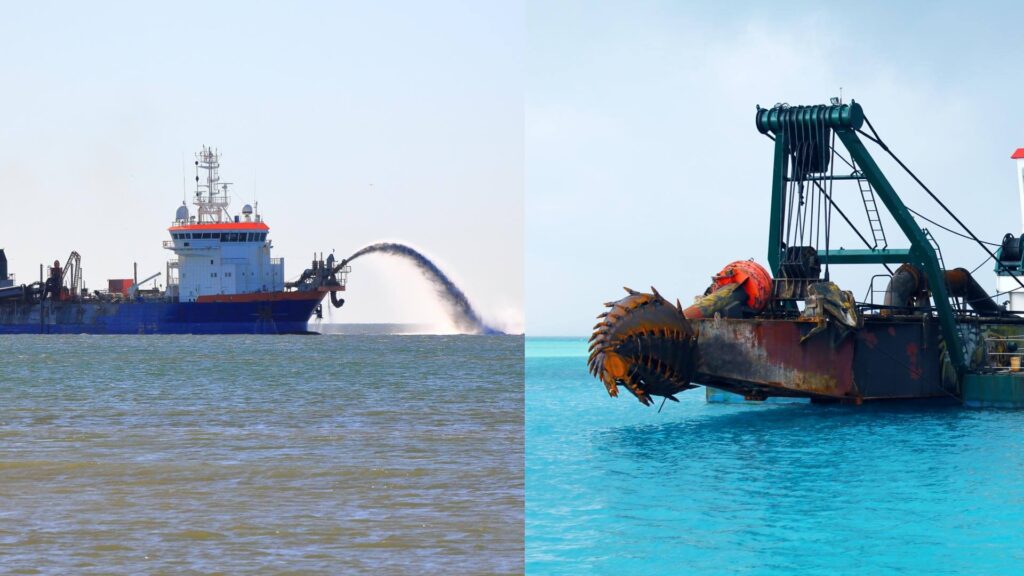
- Cutter Suction Dredgers (CSD):
Cutter suction dredgers (CSDs) are widely used in harbor dredging projects involving compacted sediments or materials like clay and sand. These dredgers feature a rotating cutter head at the suction inlet, which loosens the sediment before it is pumped out through a pipeline. CSDs are highly effective for deepening harbors or creating new navigable channels.
- Trailing Suction Hopper Dredgers (TSHD):
TSHDs are versatile harbor dredgers designed for deeper waters and areas with soft sediments like mud or silt. They use a suction pipe with a drag head that collects sediment while moving along the harbor floor. The collected material is stored in an onboard hopper for transport to disposal or reuse sites, making TSHDs ideal for maintenance dredging.
Role of Specialized Equipment in Effective Sediment Removal
Specialized harbor dredgers are essential for achieving precise and efficient sediment removal. They are designed to handle different sediment types and operational challenges, ensuring minimal disruption to harbor activities. Features such as GPS-guided systems, high-powered suction pumps, and eco-friendly designs allow for accurate dredging while reducing environmental impact.
By employing the right equipment for specific conditions, dredging for harbors ensures ports remain navigable, functional, and capable of supporting growing maritime traffic. Advanced dredgers not only enhance operational efficiency but also play a vital role in maintaining the economic and environmental sustainability of harbor ecosystems.
Why Harbors Need Regular Dredging
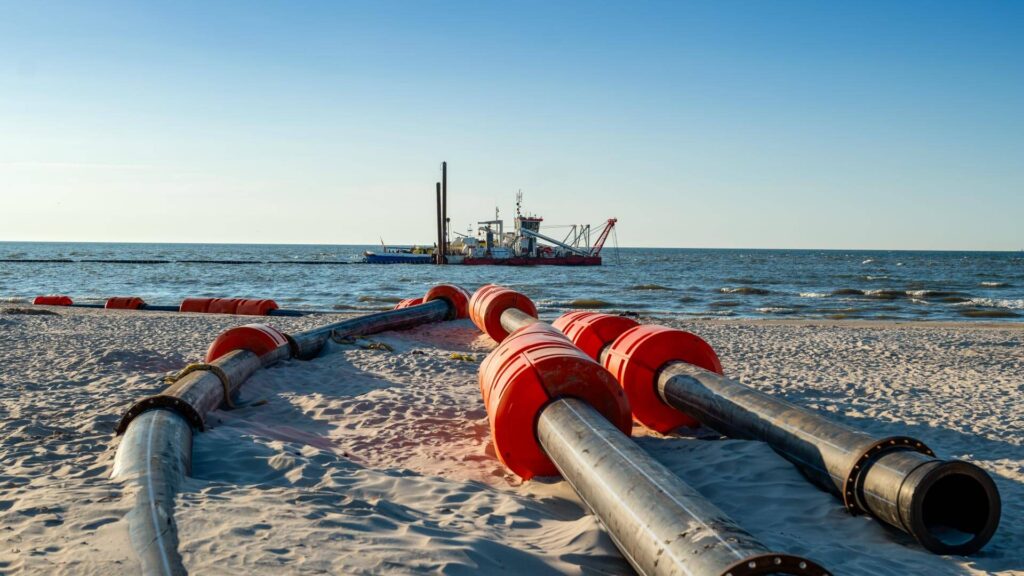
Sedimentation and Its Impact on Harbors
Sedimentation is a natural process where soil, silt, and debris accumulate on the harbor floor, gradually reducing its depth. This phenomenon is accelerated by factors such as river runoff, tidal movements, and human activities like construction near waterways. Over time, sediment buildup creates significant challenges for harbor operations, particularly in high-traffic areas.
Reduced harbor depth affects the ability of vessels to navigate safely, especially larger ships with deeper drafts. These limitations can force cargo ships to operate below capacity, increasing shipping costs and reducing port efficiency. Furthermore, sedimentation can obstruct docking areas, making cargo handling more difficult and time-consuming.
Harbor dredging is essential for combating sediment accumulation, ensuring that harbors remain deep enough to accommodate vessels of all sizes. By deploying a specialized harbor dredger, ports can maintain their depth, allowing for the smooth operation of shipping activities and minimizing disruptions caused by sediment buildup.
Preventing Shipping Delays and Congestion
Busy ports rely on efficient traffic flow to manage the large volume of ships entering and leaving daily. Sedimentation can create bottlenecks by narrowing channels and limiting navigable routes, resulting in delays and congestion. This not only disrupts global supply chains but also affects the port’s profitability and reputation.
Regular dredging for harbors ensures that shipping lanes remain open and free of obstructions, enabling vessels to move seamlessly through the harbor. A well-maintained harbor reduces the risk of grounding accidents, ensures quicker turnaround times, and supports higher cargo throughput. By investing in harbor dredging, ports can handle growing maritime traffic while maintaining their competitiveness in the global trade network.
Maintaining a harbor’s depth through consistent dredging is a vital aspect of port management, directly impacting navigation safety, cargo efficiency, and overall economic performance.
Economic Benefits of Harbor Dredging
Boosting Trade Through Increased Harbor Capacity
One of the most significant economic benefits of harbor dredging is its ability to increase a harbor’s capacity by deepening channels and berths. As global trade continues to grow, modern shipping vessels are becoming larger, requiring deeper waters to dock safely and efficiently. Without adequate depth, harbors may be unable to accommodate these large vessels, limiting their ability to handle high cargo volumes.
By deploying a specialized harbor dredger, ports can remove accumulated sediment and deepen their waterways, enabling larger vessels to access their facilities. This improvement expands trade opportunities for regional and global markets, as deeper harbors can attract more shipping lines, increasing the flow of goods and revenue. Dredging for harbors ensures ports remain competitive and capable of meeting the demands of modern maritime logistics.
Job Creation and Infrastructure Development
Harbor dredging projects contribute significantly to local and national economies by creating employment opportunities. From the planning and execution of dredging operations to the maintenance of port facilities, these projects require skilled labor and technical expertise.
Additionally, the expansion and maintenance of harbors drive infrastructure development, including the construction of new docks, warehouses, and transportation networks. These improvements support industries such as logistics, shipping, and tourism, creating a ripple effect of economic growth in surrounding communities.
Regular dredging for harbors also ensures that smaller industries, such as fishing and recreational boating, can thrive by maintaining safe and navigable waters. The economic activity generated by dredging projects extends beyond the harbor, benefiting a wide range of sectors.
Enhancing Port Competitiveness
A well-maintained harbor is a key factor in attracting shipping lines and international trade routes. Ports that invest in regular harbor dredging can offer faster turnaround times, safer navigation, and the capacity to handle larger vessels. These advantages make them more appealing to global shipping companies, increasing their market share and fostering long-term partnerships.
Additionally, competitive harbors often see increased investment in their facilities, further boosting their capacity and efficiency. By using modern harbor dredgers and adopting advanced dredging techniques, ports can position themselves as reliable and efficient hubs for international trade.
Increased competitiveness not only enhances a port’s reputation but also drives economic growth by fostering innovation and attracting new business opportunities. Harbor dredging is, therefore, a critical investment in the long-term success and sustainability of any port.
Environmental Considerations in Harbor Dredging
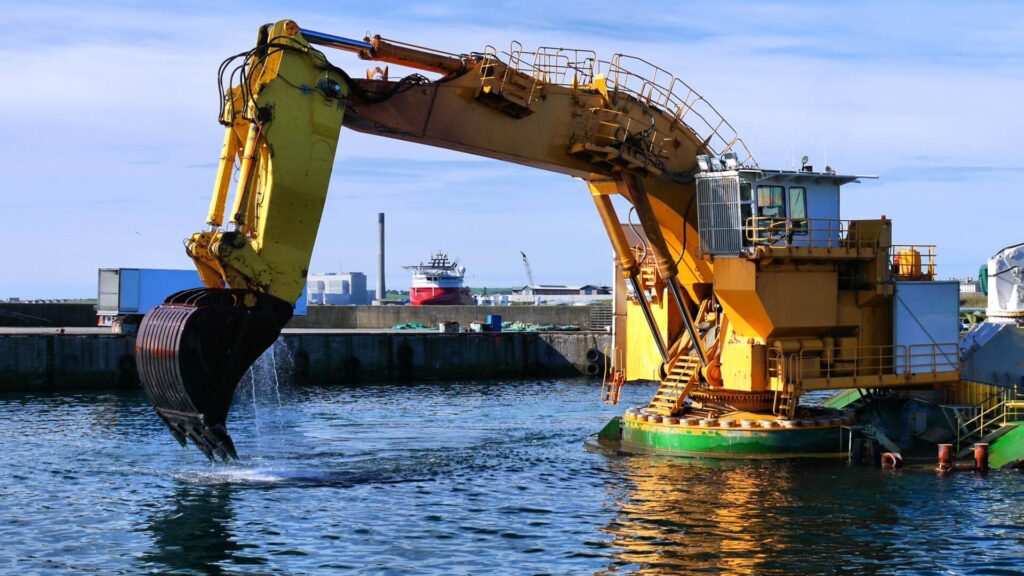
Minimizing Environmental Impact
Harbor dredging is essential for maintaining navigability and supporting economic growth. However, it must be performed responsibly to protect the surrounding ecosystems. Eco-friendly practices in dredging operations are crucial for minimizing the environmental footprint.
- Eco-Friendly Practices in Dredging Operations:
Adopting environmentally conscious methods, such as targeted dredging and real-time monitoring, helps reduce disturbances to aquatic life. These practices ensure that sediment removal focuses on specific areas, avoiding unnecessary disruptions to healthy ecosystems.
- Using Modern Harbor Dredgers to Reduce Sediment Resuspension:
Sediment resuspension during dredging can cloud the water, harm marine habitats, and spread pollutants. Modern harbor dredgers are equipped with precision suction and hydraulic systems designed to minimize sediment disturbance. Additionally, advanced technologies such as silt curtains and containment systems are often deployed to control the spread of suspended particles.
By prioritizing these measures, dredging for harbors can achieve its objectives while safeguarding water quality and aquatic biodiversity.
Managing Dredged Materials
Sustainable management of dredged materials is a critical component of environmentally responsible harbor dredging. Instead of viewing dredged sediment as waste, innovative techniques now allow for its reuse in beneficial applications.
- Sustainable Disposal and Reuse of Dredged Sediment:
Sediments removed during dredging can be repurposed for various projects, such as land reclamation, shoreline stabilization, and wetland creation. For example, dredged material can be used to rebuild eroded coastal areas or enhance habitats for fish and wildlife.
- Land Reclamation and Habitat Restoration:
Dredged sediment with appropriate composition is ideal for land reclamation projects, helping create new usable land or restore degraded areas. Additionally, it can be utilized in habitat restoration efforts, such as rebuilding nesting sites for birds or reestablishing underwater vegetation beds.
Sustainable practices in managing dredged materials not only reduce environmental impact but also turn sediment into a valuable resource, contributing to long-term ecological and economic benefits. Modern harbor dredging ensures that the balance between functionality and environmental stewardship is maintained, aligning with global efforts to protect marine environments.
Innovations in Harbor Dredging Technology
Automation and Real-Time Monitoring
Advancements in harbor dredging technology have introduced automation and real-time monitoring systems that revolutionize dredging operations.
- Integration of AI and GPS Systems for Precise Dredging Operations:
Artificial intelligence (AI) and GPS technology now allow dredgers to operate with unprecedented precision. These systems provide detailed mapping of the harbor floor, enabling targeted dredging for harbor maintenance. AI-driven automation adjusts dredging parameters in real-time based on sediment conditions, ensuring optimal efficiency and accuracy while minimizing environmental impact.
- Benefits of Real-Time Monitoring:
Real-time monitoring tools track water turbidity, sediment movement, and equipment performance during operations. This data helps operators make informed decisions, ensuring compliance with environmental regulations and reducing unintended ecological disruption.
Energy-Efficient Harbor Dredgers
Sustainability is a growing focus in harbor dredging, and energy-efficient technologies are key to reducing operational costs and environmental impact.
- Use of Electric or Hybrid Dredgers to Reduce Fuel Consumption and Emissions:
Modern harbor dredgers now incorporate electric or hybrid power systems, significantly reducing reliance on fossil fuels. These dredgers produce fewer greenhouse gas emissions, making them ideal for environmentally sensitive areas. Additionally, hybrid dredgers combine electric and conventional power sources to optimize fuel efficiency during operations, contributing to cost savings and sustainability.
- Quiet and Eco-Friendly Operations:
Energy-efficient dredgers also generate less noise pollution, which benefits marine life and reduces disturbances in busy ports near urban areas.
Advanced Sediment Management Systems
Innovations in sediment management have transformed how dredged materials are handled, turning potential waste into valuable resources.
- New Techniques for Collecting and Repurposing Dredged Materials:
Advanced sediment collection systems minimize contamination and improve the quality of dredged material for reuse. Techniques such as dewatering and sediment separation allow for cleaner and more efficient handling of materials removed during harbor dredging.
- Applications of Repurposed Sediments:
Dredged materials are increasingly being repurposed for land reclamation, shoreline stabilization, and habitat restoration. Sediments with appropriate characteristics can be used to rebuild eroded coastal areas or create new industrial and residential land.
These technological advancements in harbor dredging ensure efficient operations while prioritizing environmental sustainability. Modern innovations are reshaping the way harbors are maintained, supporting both economic growth and ecological preservation.
Factors to Consider in Harbor Dredging Projects
Harbor Size and Traffic Volume
The size of the harbor and the volume of maritime traffic it handles are critical factors in planning harbor dredging operations.
- Assessing the Scale and Requirements of the Dredging Operation:
Larger harbors with significant vessel traffic require more extensive dredging to accommodate large ships and ensure uninterrupted navigation. High-traffic harbors may need frequent maintenance dredging to prevent sediment buildup that could disrupt operations. Conversely, smaller harbors with less activity may benefit from compact, periodic dredging using a smaller harbor dredger designed for precision and cost-effectiveness.
- Prioritizing Areas for Dredging:
High-use zones, such as docking areas, navigation channels, and turning basins, should be prioritized to maximize operational efficiency and ensure the safe movement of vessels.
Sediment Type and Environmental Regulations
Understanding the composition of sediment and adhering to local environmental laws are essential for successful dredging for harbor maintenance.
- Choosing Appropriate Dredging Methods Based on Sediment Composition:
Different sediment types, such as fine silt, sand, or compacted clay, require specific dredging techniques. Hydraulic dredgers with high-efficiency pumps are ideal for loose materials, while cutter suction dredgers are better suited for tougher, compacted sediments. Choosing the right equipment ensures efficient sediment removal and minimizes wear and tear on the machinery.
- Compliance with Environmental Regulations:
Dredging operations must adhere to local and international environmental standards to protect marine ecosystems. Using advanced harbor dredgers equipped with sediment containment systems, operators can reduce turbidity and prevent contamination from spreading. Additionally, proper disposal or reuse of dredged materials must align with regulations to mitigate environmental impact.
Budget and Timeline
Balancing costs and project duration is vital to ensure that harbor dredging projects are both efficient and economical.
- Balancing Efficiency with Cost:
While modern harbor dredgers may have higher upfront costs, their advanced technologies often lead to long-term savings through reduced fuel consumption, lower maintenance, and faster project completion. For cost control, it is essential to select equipment that meets the project’s scale without overextending the budget.
- Managing Project Timelines:
Dredging projects in busy harbors must be carefully scheduled to minimize disruption to maritime traffic. By leveraging automated dredging systems and efficient planning, operators can ensure timely completion while maintaining harbor accessibility.
Considering these factors ensures that harbor dredging projects are executed effectively, meeting operational demands while protecting the environment and staying within budgetary constraints.
Future Trends in Harbor Dredging
Sustainable Practices in Dredging for Harbors
Sustainability is becoming a cornerstone of modern harbor dredging, with innovative practices aimed at reducing environmental impact while maintaining operational efficiency.
- Focus on Renewable Energy and Low-Impact Dredging Solutions:
The adoption of renewable energy-powered harbor dredgers, such as electric and hybrid models, is gaining momentum. These dredgers significantly reduce greenhouse gas emissions and fuel consumption, making them ideal for environmentally sensitive areas. Low-impact dredging techniques, including precision sediment removal and containment systems, are also being implemented to minimize disruption to marine ecosystems and water quality during dredging for harbors.
- Integration of Eco-Friendly Practices:
Ports and operators are increasingly focusing on reusing dredged materials for land reclamation and habitat restoration, further promoting sustainable harbor management.
AI-Driven Dredging Operations
Artificial intelligence (AI) is transforming harbor dredging by introducing greater automation and precision.
- The Role of Automation in Improving Precision and Reducing Costs:
AI-powered harbor dredgers use real-time data analysis and GPS mapping to optimize dredging operations. These systems can autonomously adjust dredging parameters based on sediment conditions, reducing waste and ensuring accurate removal. Automation also minimizes labor costs and enhances safety by reducing the need for manual intervention in challenging environments.
- Predictive Maintenance and Operational Efficiency:
AI-driven monitoring systems help identify potential equipment issues before they lead to downtime. This predictive approach ensures continuous operations and extends the lifespan of dredging machinery, lowering overall project costs.
Emerging Materials for Durable Harbor Dredgers
Advancements in material science are playing a crucial role in enhancing the durability and efficiency of harbor dredgers.
- Advancements in Equipment Design for Longer-Lasting, Efficient Performance:
The use of wear-resistant materials, such as high-strength alloys and reinforced polymers, is increasing the longevity of dredger components, including pumps and cutterheads. These materials are designed to withstand the abrasive nature of sediment and prolonged exposure to harsh marine conditions.
- Lightweight and Corrosion-Resistant Materials:
Lightweight, corrosion-resistant materials reduce the overall weight of dredging equipment, reducing maintenance needs and enhancing fuel efficiency. These innovations are particularly beneficial for portable dredgers used in smaller or shallow harbors.
By integrating renewable energy, AI-driven automation, and advanced materials, the future of harbor dredging is focused on creating efficient, sustainable, and cost-effective solutions. These trends are set to redefine how ports approach dredging for harbors, ensuring long-term benefits for both the environment and the global economy.
Conclusion
Harbor dredging plays a vital role in fostering global trade, creating jobs, and driving economic growth. By maintaining adequate depth and navigability, dredging ensures that harbors can accommodate larger vessels, facilitating the efficient movement of goods across regional and international markets. This enhances a port’s capacity and competitiveness, attracting more shipping lines and boosting trade opportunities.
Beyond trade, dredging for harbors stimulates local economies through job creation in sectors such as logistics, shipping, and infrastructure development. It also supports industries like tourism and fishing, which rely on well-maintained waterways. Modern innovations in harbor dredgers further amplify these benefits by ensuring operations are efficient, cost-effective, and environmentally sustainable.
By investing in regular and sustainable harbor dredging practices, ports can secure long-term economic growth while supporting the global supply chain and protecting marine ecosystems.

